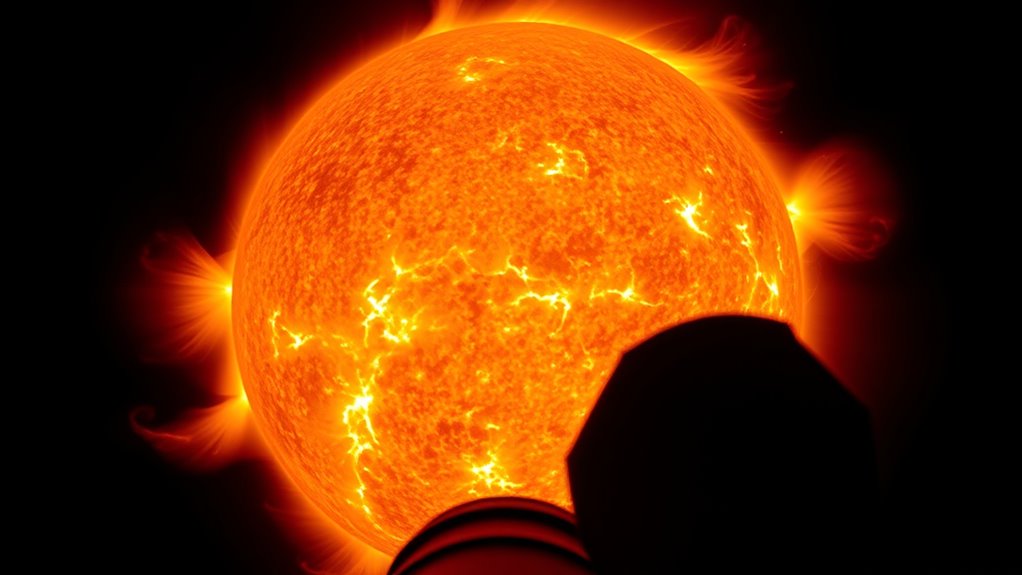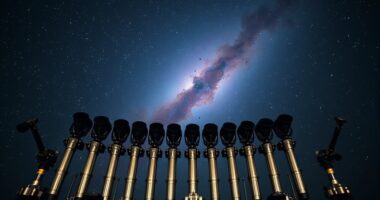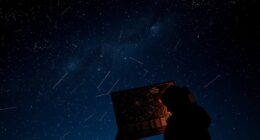If you’re looking for the 15 best solar filters for telescopes in 2025, I recommend options that prioritize safety, optical quality, and compatibility. I look for certified filters made with high-quality materials like impregnated polymer or coated glass, ensuring they block 99.999% of harmful rays. Easy to install, durable, and offering natural-looking views are key factors. Keep in mind, the right filter fits your telescope and enhances your solar observing experience—stay tuned to discover all the top picks.
Key Takeaways
- Ensure filters meet ISO 12312-2:2015(E) safety standards for reliable, secure solar viewing.
- Look for filters with high optical clarity, durable materials, and UV/IR blocking for sharp, safe images.
- Confirm compatibility with your specific telescope model and size for secure, slip-free attachment.
- Choose filters with natural tinting, like orange, providing realistic Sun views suitable for observation and photography.
- Prioritize reputable brands offering long-term durability, safety certification, and easy installation features.
Celestron EclipSmart Solar Eclipse Telescope Filter

If you’re looking for a reliable solar filter compatible with popular telescope models, the Celestron EclipSmart Solar Eclipse Telescope Filter is an excellent choice. It conforms to ISO 12312-2:2015(E), ensuring it meets strict safety standards, and is made with solar-safe film produced in the USA by American Paper Optics, recommended by NASA and the American Astronomical Society. Compatible with Celestron 8” Schmidt-Cassegrain and EdgeHD telescopes, it attaches securely with two hook and loop straps. The orange tint offers natural sun imagery, perfect for observing eclipses and sunspots safely. Plus, it’s backed by a lifetime warranty and US-based support, making it a dependable option.
Best For: amateur astronomers, eclipse viewers, and solar observation enthusiasts seeking a safe, reliable, and easy-to-use solar filter for their telescopes.
Pros:
- Conforms to strict ISO 12312-2:2015(E) safety standards, ensuring safe solar viewing
- Made with high-quality, USA-produced solar-safe film recommended by NASA and the American Astronomical Society
- Compatible with popular Celestron 8” Schmidt-Cassegrain and EdgeHD telescopes, with a secure attachment system
Cons:
- Limited to specific telescope models (Celestron 8” Schmidt-Cassegrain and EdgeHD)
- Orange tint may slightly alter the natural appearance of the Sun for some observers
- Requires proper installation and removal to maintain safety and performance
Celestron EclipSmart Solar Eclipse Telescope and Camera Filter
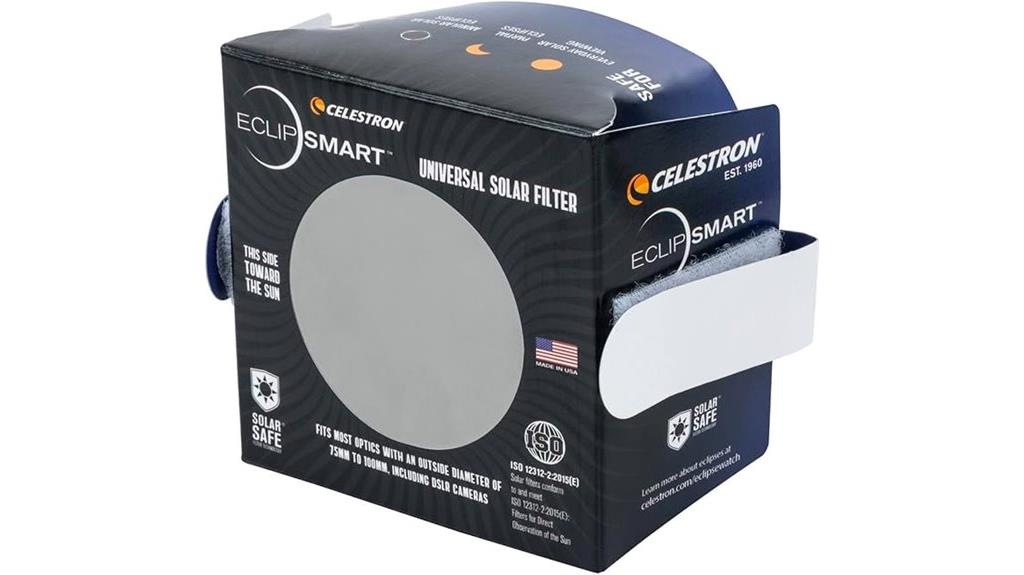
The Celestron EclipSmart Solar Eclipse Telescope and Camera Filter stands out as an excellent choice for amateur astronomers and eclipse chasers who want a reliable, easy-to-use solar filter. It conforms to ISO 12312-2:2015(E) safety standards, ensuring safe direct sun viewing. Compatible with telescopes, spotting scopes, and DSLR cameras with objectives from 75mm to 100mm, it attaches securely with adjustable side panels and elastic bands. The foldable design makes storage simple, and its orange tint provides natural visual and photographic results. Made in the USA by American Paper Optics, it’s backed by Celestron’s 2-year warranty and expert support, making it a versatile, trusted option.
Best For: amateur astronomers, eclipse enthusiasts, and astrophotographers seeking a safe, easy-to-use solar filter for observing and capturing the Sun.
Pros:
- Conforms to ISO 12312-2:2015(E) safety standards, ensuring safe sun viewing
- Compatible with a wide range of telescopes, spotting scopes, and DSLR cameras with 75mm to 100mm objectives
- Foldable and easy to attach securely, making storage and setup simple
Cons:
- Limited to devices with objective diameters between 75mm and 100mm, restricting use with larger telescopes
- Orange tint may affect natural color perception in visual observations and photography
- Requires additional accessories like lens sun shades for optimal DSLR use and secure attachment
Thousand Oaks Optical SolarLite Filter for Telescope (114mm)
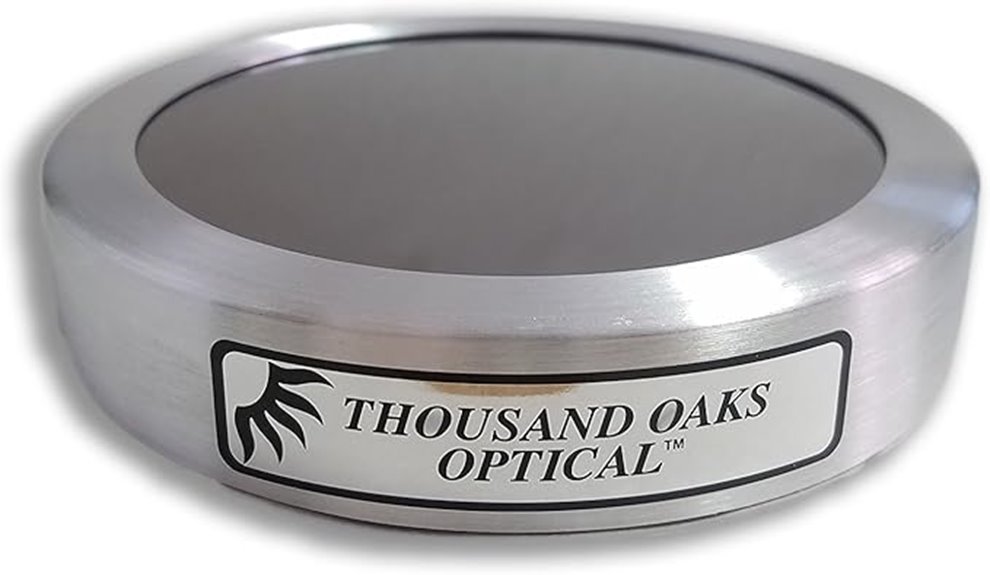
Designed for telescopes with approximately 101mm outer diameters, the Thousand Oaks Optical SolarLite Filter (114mm) offers a durable and reliable solution for solar observation and photography. Made from high-quality impregnated polymer, it combines glass-like clarity with resistance to scratches, tears, and pinholes. This lightweight, flat filter ensures consistent yellow-orange solar images and long-term durability, backed by a 15-year guarantee. It securely fits a range of popular telescopes and remains free of wrinkles or distortions. Many users praise its safety, image quality, and value, making it a trusted choice for anyone seeking clear, safe solar views.
Best For: amateur astronomers and solar observers seeking a durable, high-quality solar filter for telescopes with approximately 101mm outer diameters.
Pros:
- Made from high-quality impregnated polymer for durability and optical clarity.
- Resistant to pinholes, scratches, tears, and punctures, ensuring long-term reliability.
- Provides natural yellow-orange solar images with consistent quality and safety.
Cons:
- Requires precise measurement of telescope outer diameter for proper fit.
- Friction-fit design may need additional securing with tape in some setups.
- Not compatible with telescopes having significantly different outer diameters without adapters.
Celestron EclipSmart Solar Eclipse Telescope Filter
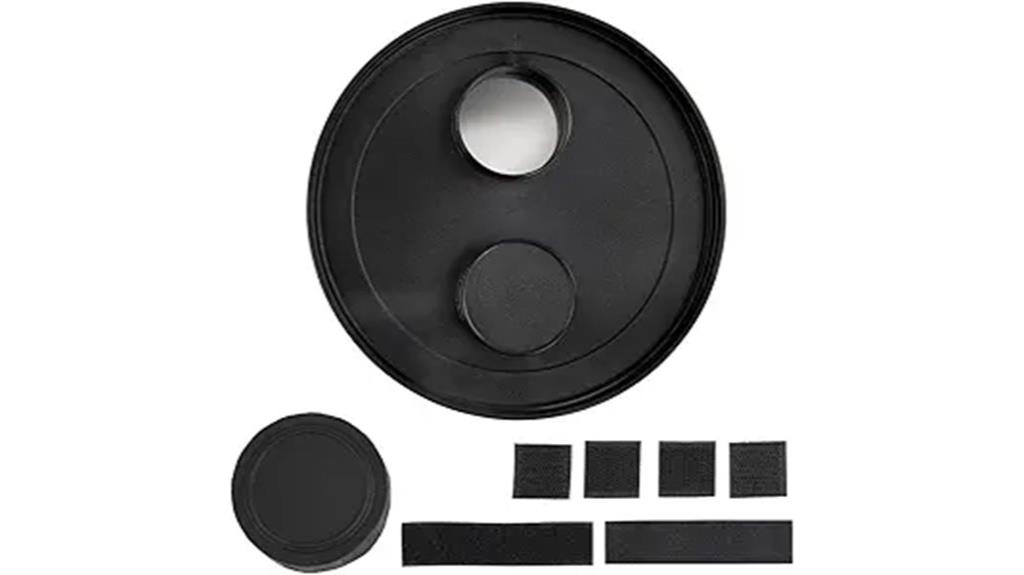
For amateur astronomers and eclipse enthusiasts seeking a safe, reliable way to observe the Sun, the Celestron EclipSmart Solar Eclipse Telescope Filter offers an excellent solution. Compatible with models like PowerSeeker 127EQ, Astro Fi 130, and NexStar 130SLT, it transforms your telescope into a solar scope. Made in the USA, it meets ISO 12312-2:2015(E) safety standards and features a high-quality solar film, providing clear, natural-looking views with an orange tint. Its secure straps and safety cap ensure safe installation and storage. Users praise its ease of use, image clarity, and safety features, making it a top choice for solar observation.
Best For: amateur astronomers and eclipse enthusiasts seeking a safe, reliable way to observe the Sun through their compatible telescopes.
Pros:
- Meets ISO 12312-2:2015(E) safety standards for secure solar viewing
- Easy to install with secure straps and a protective safety cap
- Provides clear, natural-looking views with high-quality solar film and orange tint
Cons:
- May have slight fit issues on certain telescope models or small viewing windows
- Some users find small viewing holes challenging for focusing
- Limited to compatible telescope models, requiring verification before purchase
Celestron EclipSmart Solar Eclipse Telescope Filter

If you’re looking to safely observe solar events with your existing telescope, the Celestron EclipSmart Solar Eclipse Telescope Filter is an excellent choice. It conforms to ISO safety standards and fits models like the AstroMaster 70AZ, LT 70AZ, and 70EQ. Made with Solar Safe filter technology, it blocks IR, UV, and 99.999% of visible light, ensuring safe, vivid views. The filter attaches securely with three screws and includes a protective cap. With its affordable price, ease of use, and compatibility, it’s perfect for viewing eclipses, sunspots, and the Sun’s surface. Plus, it’s backed by a lifetime warranty and US-based support.
Best For: Amateur astronomers and eclipse enthusiasts seeking a safe, easy, and cost-effective way to observe the Sun through their existing telescopes.
Pros:
- Conforms to ISO 12312-2:2015(E) safety standards, ensuring safe solar viewing
- Compatible with popular Celestron telescopes like AstroMaster 70AZ, LT 70AZ, and 70EQ
- Blocks 99.999% of visible light, UV, and IR radiation for vivid, safe solar observation
Cons:
- Designed specifically for certain Celestron models; not universally compatible with all telescopes
- Attaches with screws, which may require careful handling for secure fit
- Limited to solar viewing; not suitable for other astronomical observations
SolarLite Filter for Telescope
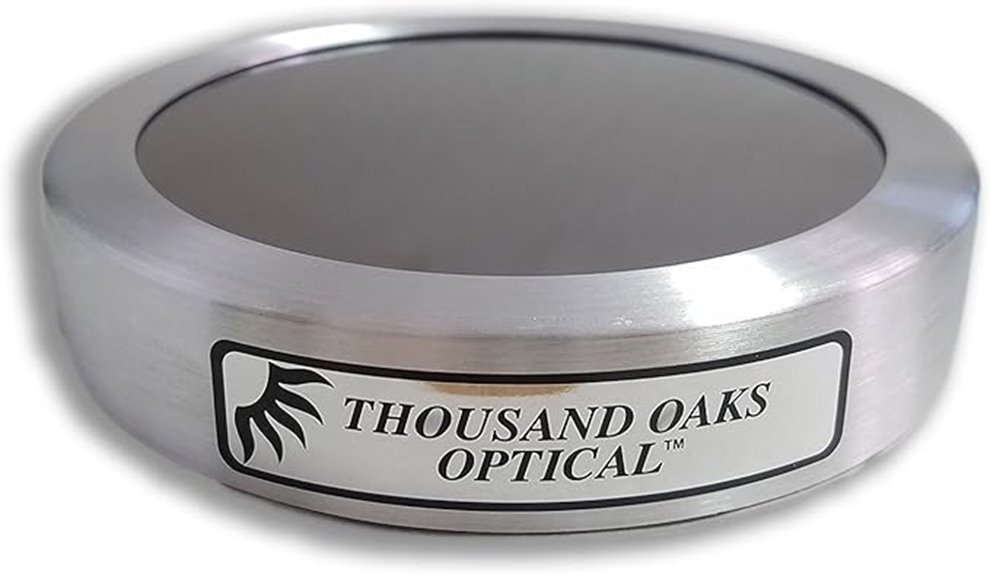
The SolarLite Filter stands out as an excellent choice for amateur and professional astronomers seeking a durable, high-quality solar filter that fits a variety of telescopes. Designed with a 108mm diameter, it’s compatible with models like the ETX90, C-90, and Orion Explorer 90, among others. Made from impregnated polymer, it offers glass-like clarity, resists scratches, tears, and pinholes, and comes with a guaranteed 15-year lifespan. Its lightweight design requires no re-balancing, and it provides a consistent yellow-orange solar image. Guarantee proper installation for safe, sharp solar viewing or photography, making it a reliable option for casual and advanced solar observers.
Best For: amateur and professional astronomers seeking a durable, high-quality solar filter compatible with a variety of telescopes for safe and sharp solar viewing and photography.
Pros:
- Made from impregnated polymer with glass-like optical quality, resisting scratches, pinholes, and tears.
- Lightweight, flexible, and does not require re-balancing of the telescope; maintains a flat, stable surface for clear images.
- Guaranteed 15-year lifespan, offering long-term durability and excellent value.
Cons:
- Fits only telescopes with outer diameters up to 0.50 inches; may not be suitable for larger or different models.
- Some users report fit issues with certain telescopes, requiring careful measurement or modification for a snug fit.
- Slightly higher price point compared to basic solar film options, though justified by durability and optical quality.
Helios Glass Telescope Solar Filter by Seymour Solar (Fits 118mm to 124mm)
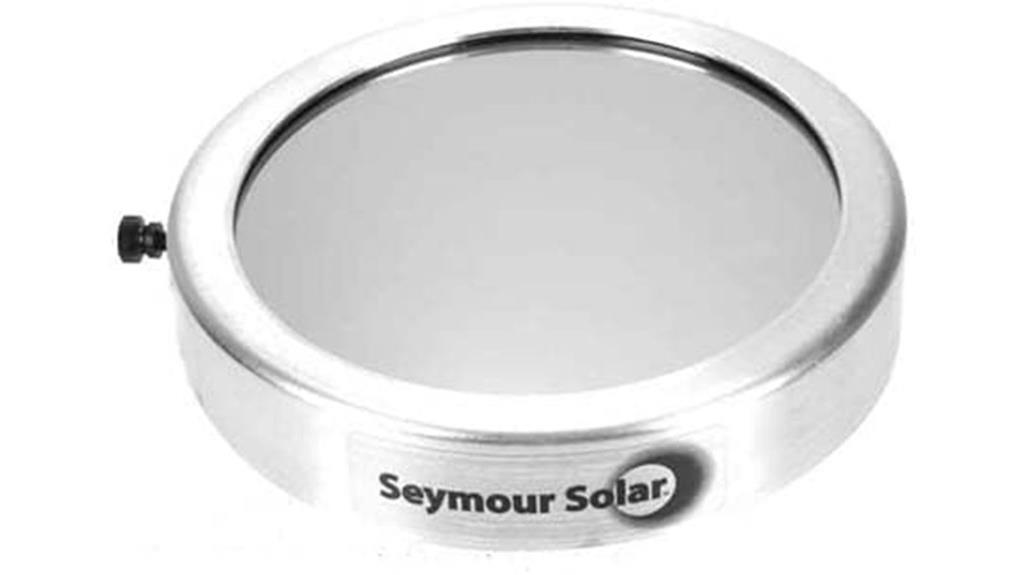
The Helios Glass Telescope Solar Filter by Seymour Solar stands out as an excellent choice for amateur astronomers and astrophotographers seeking safe and high-quality solar viewing, especially those with telescopes measuring between 118mm and 124mm. Made from high-quality Helios Solar Glass with reflective coatings on both sides, it provides a clear, high-contrast image of the Sun, revealing sunspots and solar features. Its durable aluminum outer cell ensures protection during use, while the clamp-on design with thumb screws makes attachment quick and secure. Perfect for observing partial and total eclipses or capturing solar phenomena, it combines safety, convenience, and excellent optical performance.
Best For: Amateur astronomers and astrophotographers with telescopes measuring between 118mm and 124mm seeking safe, high-contrast solar observation and photography.
Pros:
- Made from high-quality Helios Solar Glass with reflective coatings for clear, detailed solar images
- Secure clamp-on design with thumb screws ensures easy and safe attachment to compatible telescopes
- Provides 99.999% sunlight blockage (ND5 rating), ensuring safe viewing of sunspots, eclipses, and solar features
Cons:
- Limited to telescopes within the 118mm to 124mm diameter range, restricting compatibility outside this size
- May require precise adjustment to ensure a snug fit, especially on slightly irregular telescope tubes
- Does not include additional accessories like adapters or mounting hardware beyond the clamp mechanism
Hyperion Solar Film Telescope Filter

Designed for amateur astronomers and solar enthusiasts, the Hyperion Solar Film Telescope Filter offers a safe and reliable way to observe the sun’s features. Made in the USA, it fits telescopes with diameters from 4 7/8″ to 5 1/8″, and is also compatible with binoculars, cameras, and smartphones. Constructed from Hyperion Solar Film rated ND5, it blocks over 99.999% of sunlight, UV, and IR radiation, ensuring safe viewing of sunspots and eclipses. Its durable aluminum outer shell makes it lightweight and easy to handle. With simple clamp-on or slip-on installation, it stays centered during use for clear, detailed solar imaging.
Best For: amateur astronomers, solar enthusiasts, and photographers seeking a safe and effective way to observe and capture solar phenomena through telescopes, binoculars, cameras, or smartphones.
Pros:
- Provides safe viewing by blocking over 99.999% of sunlight, UV, and IR radiation.
- Compatible with a wide range of optical devices including telescopes, binoculars, cameras, and cell phones.
- Durable, lightweight aluminum construction with easy clamp-on or slip-on installation for secure use.
Cons:
- May require precise fitting to certain telescope diameters within the specified range.
- Limited to solar observation; not suitable for general astronomical or night sky viewing.
- Customer rating of 4.2 out of 5 stars suggests some users may experience fit or clarity issues.
Thousand Oaks Optical SolarLite Filter for Telescope
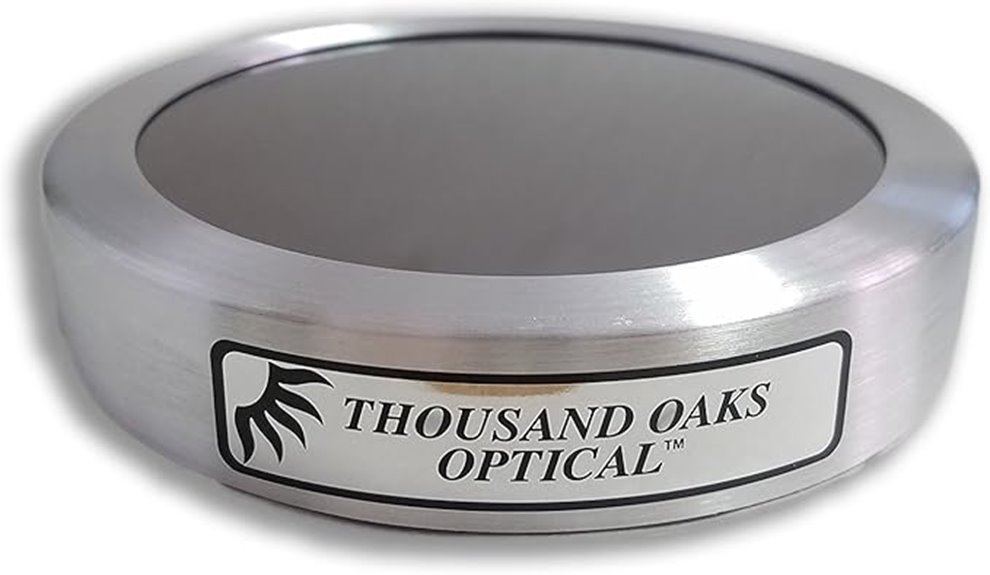
If you’re looking for a durable and reliable solar filter that fits telescopes with a 90mm diameter, the Thousand Oaks Optical SolarLite Filter is an excellent choice. Made from black polymer and optical-quality glass, it resists pinholes, scratches, tears, and wrinkles, ensuring long-lasting performance. Its lightweight design requires no re-balancing, and it provides consistent yellow-orange solar images with even density. Compatible with popular models like the TV Ranger and Williams Optics ZS66, it fits securely with a friction cap. Guaranteed for 15 years, it offers a safe, clear, and stable view of the sun, making it a top pick for dedicated solar observers.
Best For: Amateur and professional solar observers seeking a durable, safe, and high-quality solar filter for their 90mm diameter telescopes.
Pros:
- Combines optical-quality glass with impregnated polymer for durability and resistance to pinholes and scratches
- Provides consistent yellow-orange solar images with even density across apertures
- Guaranteed for 15 years, ensuring long-term reliable performance
Cons:
- Only compatible with telescopes up to 90mm diameter, limiting use with larger models
- Requires proper attachment and security measures, such as sticky tape, to ensure safety during use
- Slightly heavier and thicker than thin film filters, which may affect some mounting setups
Rainbow Symphony Solar Filter 70mm Black Polymer
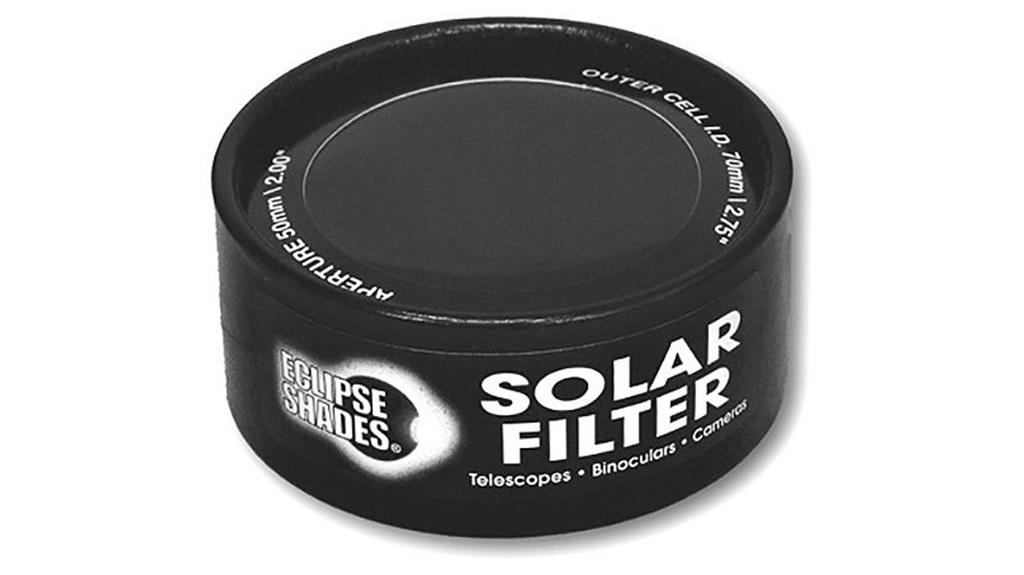
For casual astronomers or families seeking an affordable way to observe the sun, the Rainbow Symphony Solar Filter 70mm Black Polymer offers an excellent option. It’s lightweight, easy to attach to telescopes, binoculars, or cameras, mainly designed for 70mm scopes but adaptable with felt strips and tape. Made from cardboard and black polymer film, it’s best for single-event use like solar eclipses rather than frequent, long-term viewing. While affordable and safe when inspected properly, it’s less durable than glass filters. I recommend checking fit carefully and inspecting for pinholes before each use to guarantee a safe, clear view of sunspots and solar phenomena.
Best For: casual astronomers, families, and beginners seeking an affordable, lightweight solar viewing solution primarily for single-event observations like solar eclipses.
Pros:
- Affordable and easy to attach to telescopes, binoculars, or cameras
- Provides safe, natural-looking images of the sun with visible sunspots
- Lightweight and simple to set up, ideal for educational and family activities
Cons:
- Made from cardboard with limited durability, prone to damage or pinholes
- Fits may be loose; requires careful measurement and potential adjustments with tape or felt strips
- Not suitable for prolonged or frequent use due to material limitations
Smartphone Solar Imaging Photo Lens CPLS1PK
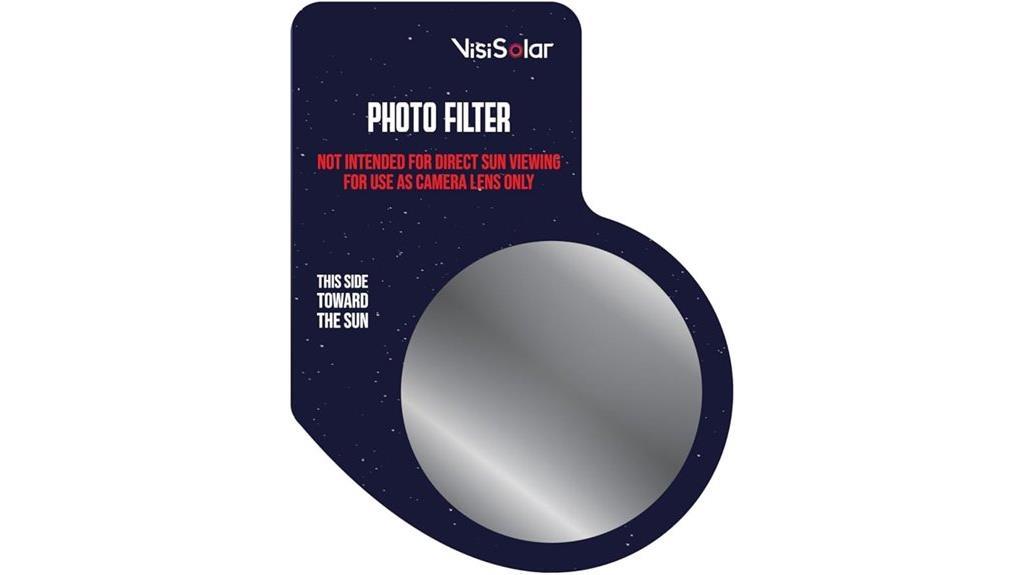
The Smartphone Solar Imaging Photo Lens CPLS1PK stands out as an ideal choice for amateur astronomers and solar enthusiasts keen to capture stunning solar events with minimal equipment. It transforms your smartphone into a dedicated solar imaging device, perfect for photographing partial phases, the diamond ring effect, and totality. This lens ensures each stage of a solar event is captured with clarity and detail, preserving unforgettable moments. It also provides essential safety features, shielding your phone’s camera from harmful solar rays. Designed for ease of use, the CPLS1PK makes solar imaging accessible, allowing you to enjoy safe, high-quality solar photography without complicated setups.
Best For: amateur astronomers and solar enthusiasts seeking an easy, safe way to capture detailed solar events using their smartphones.
Pros:
- Converts smartphones into dedicated solar imaging devices for high-quality photos
- Protects phone camera from harmful solar rays during imaging sessions
- Easy to use, requiring minimal setup for capturing solar phenomena
Cons:
- May require a steady hand or tripod for optimal image stability
- Limited compatibility with some smartphone models or camera types
- Does not include additional accessories like tripods or filters for extended photography options
Baader Planetarium AstroSolar Digital Solar Filter for Telescopes

The Baader Planetarium AstroSolar Digital Solar Filter stands out as an excellent choice for amateur and professional astronomers seeking high-quality white-light solar observation. Its optical performance delivers unmatched clarity, revealing intricate solar details with exceptional contrast, perfect for high-resolution imaging. The filter’s advanced technology provides robust protection by effectively blocking harmful radiation, ensuring safe observation for both eyesight and equipment. Designed to fit 100mm apertures, it’s easy to install with included screws, washers, and centering bolts. Made from durable, high-quality materials, it maintains performance over time, making it a reliable tool for both casual and professional solar studies.
Best For: amateur and professional astronomers seeking high-quality, safe white-light solar observation and imaging.
Pros:
- Exceptional optical clarity reveals intricate solar details with high contrast.
- Robust protection technology ensures safe observation for eyesight and equipment.
- Easy installation with included screws, washers, and centering bolts; durable construction ensures long-lasting performance.
Cons:
- Designed specifically for 100mm aperture telescopes, limiting compatibility with larger scopes.
- May require additional accessories or adapters for certain telescope models.
- The filter is primarily intended for white-light observation; not suitable for H-alpha or other specialized solar viewing.
Celestron 1.25 inch Moon Filter
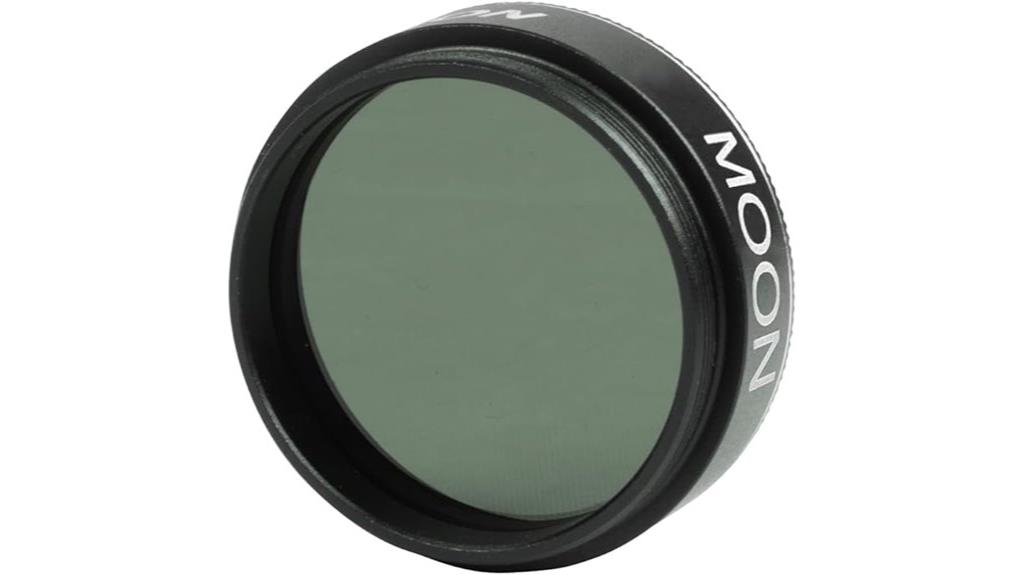
If you’re looking to enhance your lunar and planetary observations, the Celestron 1.25-inch Moon Filter is an excellent choice. It reduces glare and boosts contrast, revealing more detail on the Moon and bright planets. The filter threads onto most 1.25-inch eyepieces, making setup quick and straightforward. It improves image clarity by filtering out excess light, so you see craters, maria, and planetary features more clearly and comfortably. Backed by a 2-year US warranty and unlimited support, this filter offers reliable performance for amateur astronomers seeking sharper, more detailed views of our celestial neighbors.
Best For: amateur astronomers and stargazing enthusiasts seeking clearer, more detailed views of the Moon and bright planets.
Pros:
- Reduces glare and increases contrast for enhanced lunar and planetary detail
- Easy to install by threading onto most 1.25-inch eyepieces
- Backed by a 2-year US warranty and dedicated support for reliable performance
Cons:
- Designed primarily for bright objects; less effective for faint deep-sky objects
- Only compatible with 1.25-inch eyepieces, not larger formats
- May slightly dim the overall image, requiring adjustments for optimal viewing
Celestron Accessory Kit with Eyepieces, Barlow & Filter Set

Designed for amateur astronomers who want versatile and high-quality accessories, the Celestron Accessory Kit with Eyepieces, Barlow, and Filters offers an excellent upgrade for observing the moon, planets, and deep-sky objects. It includes five 1.25-inch Plössl eyepieces (6mm, 8mm, 13mm, 17mm, 32mm) with multicoated optics for sharp, high-contrast images. The 2x Barlow doubles magnification, expanding your options. Six planetary filters and a moon filter enhance surface detail and reduce brightness. All accessories fit securely in a sturdy, foam-lined case, making it easy to organize and transport. This kit provides a reliable, expandable toolkit for serious amateur astronomers.
Best For: amateur astronomers seeking a versatile, high-quality accessory kit to enhance their telescope viewing experience of the moon, planets, and deep-sky objects.
Pros:
- Includes a comprehensive set of five multicoated Plössl eyepieces for various magnifications and sharp images
- Comes with a 2x Barlow lens to double the available magnification options
- Features six planetary filters and a moon filter to improve surface detail and viewing comfort
Cons:
- Slightly heavier and larger, which may require careful handling during transport
- Limited to 1.25-inch focusers; not compatible with larger eyepieces or accessories
- Requires proper organization to keep track of multiple small components in the included case
SVBONY 1.25-inch UHC Telescope Filter
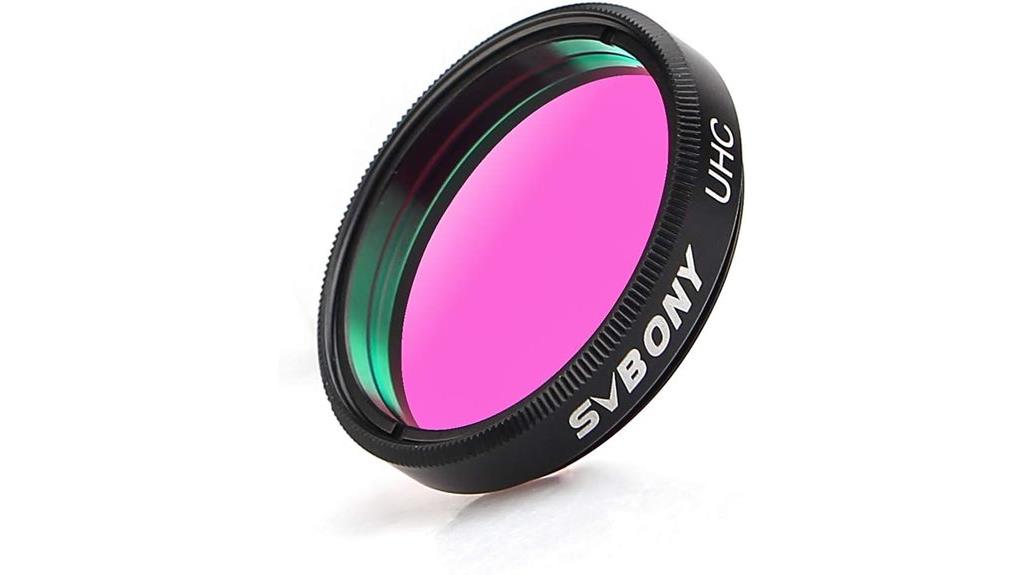
For astronomers seeking to enhance their views of nebulae and minimize light pollution, the SVBONY 1.25-inch UHC Telescope Filter offers a valuable solution. This filter improves contrast by selectively transmitting specific wavelengths, especially those emitted by emission nebulae, while blocking artificial light from urban areas. Its sturdy aluminum frame and optical glass lens ensure durability and sharp images. Compatible with standard eyepieces, it’s easy to attach and use. Whether for visual observation or astrophotography, this filter darkens the sky background and highlights celestial details. At just over half an ounce, it’s lightweight and portable, making it a versatile addition to any stargazing kit.
Best For: amateur astronomers and astrophotographers seeking to improve contrast and reduce light pollution during celestial observation and astrophotography sessions.
Pros:
- Enhances image contrast by blocking artificial light and emphasizing emission nebulae
- Durable construction with a sturdy aluminum frame and high-quality optical glass lens
- Easy to attach to standard 1.25-inch eyepieces, making it convenient for quick setup
Cons:
- May not be compatible with larger 2-inch eyepieces or accessories without adapters
- Designed primarily for use in moderate to heavily light-polluted areas, less necessary in dark skies
- Slight decrease in overall brightness due to light filtration, which could affect very faint object viewing
Factors to Consider When Choosing Solar Filters for Telescopes

When selecting a solar filter, I prioritize safety certification standards to guarantee reliable protection. Compatibility with my telescope and the optical clarity and tint are also key factors I consider. Additionally, I look for durable materials and easy installation to make observing the sun both safe and hassle-free.
Safety Certification Standards
Ensuring solar safety starts with verifying that your telescope’s solar filter meets established certification standards. Look for certification from recognized organizations like ISO 12312-2:2015(E), which sets strict guidelines for solar filters. These standards guarantee the filter effectively blocks harmful UV, IR, and visible radiation, protecting your eyes during solar viewing. Certified filters typically transmit less than 0.0001% of sunlight, ensuring safe observations. It’s essential that the product packaging or documentation clearly indicates this certification, so you can confirm its safety. Approved filters are made from specialized materials, such as solar-safe film or glass, which meet rigorous safety and optical quality requirements. Never use a filter without proper certification, as substandard options may pose serious eye risks.
Compatibility With Equipment
Matching your solar filter to your telescope’s equipment is essential for safe and effective solar viewing. First, confirm the filter’s diameter matches your telescope’s objective lens or aperture for a secure fit. Check if the filter is compatible with your specific telescope model, whether it’s a Schmidt-Cassegrain, refractor, or reflector. Pay attention to the attachment mechanism—whether it’s hook and loop straps or screw-in threads—and verify it aligns with your equipment’s design. Also, verify that the filter’s material and safety standards suit your telescope’s size and your solar observation plans. If you want to use accessories like cameras or smartphone adapters, make sure the filter allows for those attachments. Proper compatibility ensures safety and versatility during your solar viewing sessions.
Optical Clarity and Tint
Optical clarity is vital for getting sharp, detailed views of solar features like sunspots and prominences through your telescope. High-quality filters offer excellent clarity, preventing light leakage and pinholes that could compromise image quality and safety. A natural or neutral tint, such as an orange hue, provides a more realistic view of the Sun, making observations more comfortable and accurate. The optical performance directly impacts your ability to capture high-resolution images of solar phenomena, which is essential for astrophotographers. Additionally, the tint level influences contrast and color balance, affecting both visual enjoyment and photographic results. Choosing a filter with superior clarity and an appropriate tint ensures you get the best possible views of the Sun’s intricate details while maintaining safety standards.
Durability and Material Quality
Choosing a durable solar filter is vital because it directly affects both safety and image quality during your observations. High-quality filters are crafted from strong materials like impregnated polymer or specially coated glass, which resist scratches, tears, and punctures. Material strength determines how long the filter will last—many premium options promise 15 years or more of reliable use. It’s essential that the construction prevents light leaks and pinholes, maintaining consistent, safe views over time. Lightweight, flexible materials like polymer films often outperform fragile glass in resisting physical impacts. Additionally, properly manufactured solar filters undergo rigorous testing to meet safety standards, ensuring their material integrity stays intact through repeated use. This combination of quality and durability guarantees safe, clear solar imaging for years to come.
Ease of Installation
A solar filter’s ease of installation is crucial for a safe and hassle-free viewing experience. I look for filters that attach quickly and securely without needing special tools or complicated steps. Features like adjustable straps, hook-and-loop fasteners, or screw-on mechanisms make fitting the filter straightforward on different telescope models. Clear instructions are essential, so I prefer options designed for all experience levels, including beginners. A snug, slip-free fit prevents accidental exposure to unfiltered sunlight, ensuring safety and convenience. Foldable or flexible designs also help with storage and transport, making setup in the field easier. Ultimately, the simpler the installation process, the more enjoyable and secure your solar viewing sessions will be.
Price and Value
Since the price of solar filters varies widely, it’s important to weigh cost against the quality and safety features they offer. Budget options around $10 may seem appealing, but they often compromise safety or optical clarity. Higher-end glass filters costing over $200 typically provide better durability, UV/IR protection, and clearer solar images, offering more value over time. Evaluating certifications, material quality, and customer reviews helps determine if a higher price truly reflects better performance and safety standards. Investing a little more in well-reviewed filters can save money in the long run by avoiding replacements and ensuring safe, crisp views of the Sun. Remember, the cheapest option isn’t always the best—prioritize quality and safety to get the best value.
Long-Term Usage Considerations
Long-term usage of solar filters depends on selecting durable materials and maintaining their condition over time. High-quality filters made from impregnated polymer or solar glass usually last 10 to 15 years if properly cared for. Regular inspections are essential—look out for pinholes, scratches, or tears, as even small damages can jeopardize safety and image clarity. Proper storage in protective cases and avoiding exposure to extreme temperatures or direct sunlight can considerably extend their lifespan. It’s vital to replace filters at the first sign of damage or deterioration to guarantee safe, ideal viewing. Choosing filters with a solid warranty and high durability ratings offers extra confidence in their long-term performance, helping you enjoy safe and clear solar observations for many years.
Frequently Asked Questions
What Are the Key Safety Features of Top Solar Filters?
The key safety features of top solar filters include sturdy, optical-grade materials that block 99.999% of harmful rays, ensuring safe viewing. They also have secure mounting mechanisms to prevent accidental slips or exposure, along with UV and IR protection to shield your eyes. Additionally, high-quality filters are free from scratches or pinholes, which could let dangerous light through, so I always check for these before use.
How Do Different Filter Types Affect Solar Image Clarity?
Different filter types notably impact solar image clarity. My experience shows that glass filters offer sharp, high-contrast views, while Mylar filters tend to produce softer images with some color distortion. Hydrogen-alpha filters reveal detailed solar features but require precise tuning, and solar film filters balance safety with decent clarity. Your choice depends on whether you prioritize sharpness, detail, or ease of use for safe solar observation.
Can Solar Filters Be Used for Astrophotography?
Yes, solar filters can be used for astrophotography, but with caution. I recommend using high-quality, specialized solar filters designed for astrophotography to protect your equipment and eyes. They enable capturing detailed solar features like sunspots and prominences. Keep in mind, regular photographic filters aren’t suitable, and safety is paramount—never look directly at the Sun without proper protection, especially during long exposures.
Are There Specific Filters Recommended for Certain Telescope Sizes?
Think of your telescope as a tailored suit—each size needs a perfect fit. For smaller telescopes, I recommend lightweight, thin filters that won’t weigh down the eyepiece. Larger scopes benefit from sturdy, full-coverage filters that stay secure. Always check the manufacturer’s recommendations; a poorly fitting filter can be as risky as a loose shoe. Matching your filter to your telescope size guarantees clear, safe solar views every time.
How Long Can I Safely Observe the Sun With a Solar Filter?
You can safely observe the sun through a solar filter for as long as the filter remains intact and free of damage. I always check my filter before each use, ensuring there are no scratches or holes. Generally, I avoid prolonged viewing sessions to prevent overheating or damage. Remember, if the filter shows any signs of wear, replace it immediately to stay safe and protect your eyes.
Conclusion
Choosing the right solar filter transforms a simple view into a breathtaking window to the sun’s fiery surface. Imagine gazing safely as sunspots dance across a glowing disk, revealing nature’s fiery masterpiece with clarity and confidence. With these top picks, you’ll enjoy stunning, safe solar observations that feel like peering into a celestial wonderland. So, gear up, focus, and let the sun’s majestic beauty unfold before your eyes.
